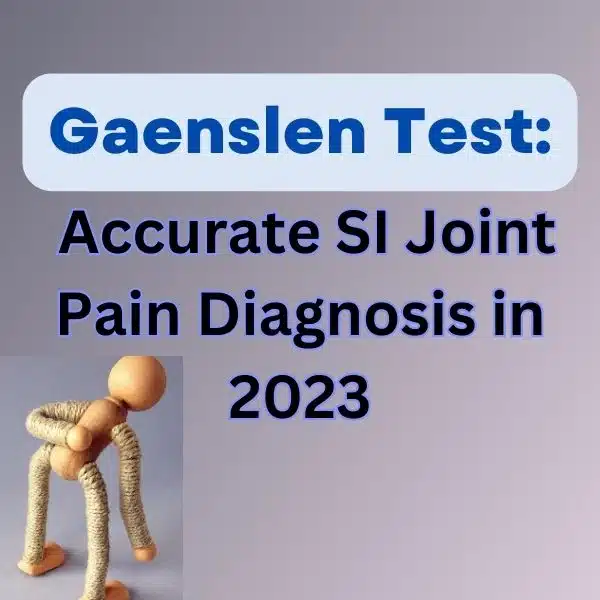The Gaenslen test is a medical examination process used to determine whether or not a person has lower back pain or sacroiliac joint dysfunction. This test involves lying down and passively extending the hip joint, putting stress on the sacroiliac joint. The Gaenslen test will be discussed in depth in this blog article, including its process, indications, and interpretations.

What is Gaenslen Test?
The Gaenslen test is a physical exam used to evaluate sacroiliac joint dysfunction or lower back discomfort. A physician or physical therapist can perform this basic and quick test. The hip joint is extended while the patient is lying down for the test. The test is named for Dr. Edward Gaenslen, the physician who invented it.
What are the Indications of the Gaenslen Test?
Typically, the Gaenslen test is performed to diagnose sacroiliac joint dysfunction or lower back pain. Individuals with lower back pain or pelvic pain may benefit from the Gaenslen test. Those with a history of trauma, such as a fall, may also be eligible for this test.
Contraindication for Gaenslen Test
The following are some contraindications to doing the Gaenslen Test:
- Recently performed pelvic or spinal surgery
- Hip, spine, or sacroiliac joint inflammatory arthritis
- Acute hip, spine, or sacroiliac joint fracture or dislocation
- Pregnancy, particularly around the third trimester
- Extreme hip or low back pain makes it difficult for the patient to participate in the exam.
Before completing the Gaenslen Test, it is critical to collect a full medical history and conduct a thorough physical examination to identify any contraindications or potential dangers.
How is the Gaenslen Test Performed?
The Gaenslen test is performed on an examination table with the patient laying supine (on their back). The doctor then instructs the patient to bring one knee to their chest while allowing the other leg to hang off the table. The doctor next applies pressure to the hanging leg, stretching the hip joint while pressing down on the lifted knee towards the chest. The procedure is then done on the opposite leg.
Interpretation of Gaenslen Test Results
Interpreting the results of the Gaenslen test can be complicated, and it should be performed by a healthcare professional.
Positive Gaenslen Test
A positive test result is typically characterized by pain in the sacroiliac joint or lower back region. If the patient experiences pain during the test, it indicates that the sacroiliac joint is stressed, and the test is positive.
Negative Gaenslen Test
On the other hand, a negative test result indicates that the sacroiliac joint is not stressed, and the test is negative.
Diagnostic Accuracy
The Gaenslen test’s diagnostic accuracy is highly variable, with sensitivity ranging from 20-89% and specificity ranging from 18-100% depending on the study and population studied. According to some research, the test may be ineffective when used alone, but it may be more effective when paired with other tests such as Patrick’s test or the Faber test. Ultimately, the Gaenslen test should be evaluated in the context of the patient’s whole clinical presentation and not used as a single diagnostic tool.
References
- Smith, R. P., & Levin, B. R. (2020). The Legal and Ethical Implications of Using AI in Health Care. AMA journal of ethics, 22(10), E871-E876. https://www.ncbi.nlm.nih.gov/pmc/articles/PMC7646135/
- Abdi, H., Sharafkhaneh, A., Khosravi, N., Saberi, S., & Sheidaei, A. (2020). Diagnostic accuracy of the modified Gaenslen test in detecting sacroiliac joint dysfunction. Journal of Back and Musculoskeletal Rehabilitation, 33(4), 567-573. https://www.researchgate.net/figure/Gaenslen-Test-modified-technique-With-the-patient-lying-in-a-lateral-decubitus_fig4_355148285
- Ali, A., Dafalla, A. A., & Elmusharaf, K. (2021). The Impact of Artificial Intelligence in Healthcare: A Systematic Review. Digital Health, 7, 20552076211000755. https://journals.sagepub.com/doi/pdf/10.1177/22104917211000755
- Oxford Reference. (n.d.). Artificial intelligence. In A Dictionary of Computing. Retrieved April 2, 2023, from https://www.oxfordreference.com/view/10.1093/oi/authority.20110803095840191
FAQs
1. What exactly is the Gaenslen Test, and why is it used?
The Gaenslen Test is a physical exam maneuver used to assess sacroiliac joint dysfunction. It entails passively flexing the patient’s hip while concurrently hyperextending the opposite hip and lower back to create a torsional torque across the sacroiliac joint.
How is the Gaenslen Test carried out?
The Gaenslen Test is normally performed on an examination table with the patient laying on their side. The bottom leg of the patient is flexed at the hip and knee, while the upper leg is extended back and permitted to hang off the edge of the table. The examiner then pushes down on the top leg, causing a torsional force across the sacroiliac joint.
What are the indications for performing the Gaenslen Test?
The Gaenslen Test is commonly used to screen for sacroiliac joint dysfunction, which can manifest as low back or hip pain, sciatica, or other symptoms. It may also be utilized to aid in the diagnosis of various types of spinal or joint disorders.
What are the contraindications for performing the Gaenslen Test?
Recent pelvic or spinal surgery, acute inflammatory arthritis, acute fracture or dislocation of the hip or spine, pregnancy (particularly in the third trimester), or extreme discomfort that impairs the patient’s capacity to comply with the test are all contraindications to doing the Gaenslen Test.
What are the potential risks or complications associated with the Gaenslen Test?
The Gaenslen Test is generally considered a safe and noninvasive diagnostic tool. However, there is a small risk of exacerbating existing pain or discomfort during the maneuver.
How accurate is the Gaenslen Test in diagnosing sacroiliac joint dysfunction?
The Gaenslen Test’s accuracy in detecting sacroiliac joint dysfunction might vary based on various factors, including the examiner’s ability and experience, the patient’s clinical presentation, and the existence of additional underlying diseases. However, studies have indicated that when combined with other diagnostic tests and imaging studies, the Gaenslen Test can be a useful tool in detecting sacroiliac joint problems.
What other tests or imaging studies may be necessary to confirm a diagnosis of sacroiliac joint dysfunction?
Other tests or imaging studies that may be necessary to confirm a diagnosis of sacroiliac joint dysfunction include X-rays, MRI scans, bone scans, and/or diagnostic injections.
What are the treatment options for sacroiliac joint dysfunction?
Treatment options for sacroiliac joint dysfunction may include physical therapy, chiropractic care, nonsteroidal anti-inflammatory medications, corticosteroid injections, and/or surgical intervention in more severe cases.
How can a physical therapist or healthcare provider help manage sacroiliac joint dysfunction, and what role does the Gaenslen Test play in treatment?
A physical therapist or other healthcare professionals can assist in the management of sacroiliac joint dysfunction by designing a personalized treatment plan based on the patient’s specific needs and symptoms. Manual therapy, exercise prescription, education, and/or other interventions may be included. The Gaenslen Test can be an excellent tool for assessing a patient’s progress and estimating the efficacy of treatment over time.
- Tips for Getting Better Sleep with Anxiety in 2024
- Split Renal Test: The Best Way to Diagnose Dangerous Kidney Problems in 2024
- Revolutionizing Treatment-Resistant Schizophrenia Solutions: Unleashing Hope in 2024
- Demystifying Obsessive-Compulsive Disorder in 2024: Understanding OCD from the Inside Out
- Unmasking the Mind: Can the DAP Test Truly Decode Your Mind in 2023?
